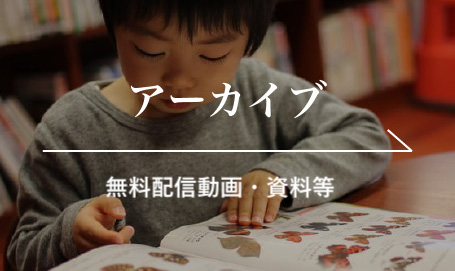< VOLUME 54, No.2>
Yuko Koyama. Kurahashi Souzou’s Thoughts on the Unification of Kindergarten and Nursery School Systems Through His Theory of Child Protection:Focusing on Children’s Dignity and Developmental Stage.
Research on Early Childhood Care and Education in Japan, 2016, 54(2),104-115.
This study aims to analyze Kurahashi Souzou’s thoughts on the unification of kindergarten and nursery school systems through his theory of child protection and his contribution to the organization of preschool systems. He proposed that children of 3.4 years and over should get equal access to early childhood education under the control of the Ministry of Education, and children under 3 years old should get care at the day nursery under the control of the Ministry of Health and Welfare. He thought: (1) Every child should have equal access to early childhood education as a matter of children’s dignity, and therefore the content of child care and education in kindergarten and nursery school should be standardized. (2) Early childhood facilities and systems should be divided in two from the perspective of the developmental stage. (3) Kindergarten should also provide a comprehensive child protection service.
Keywords: unification of kindergarten and nursery school systems, child protection, children’s dignity, developmental stage, contents of child care and education
—————–
Makoto Nakane. Re-valuation of Takayuki Namae as a Pioneer of Day Nursery Projects:Focusing on
His Time as a Kobe City Official.
Research on Early Childhood Care and Education in Japan, 2016, 54(2), 116-125.
This paper aims to reevaluated the contribution of Takayuki Namae as a pioneer of day nursery projects, focusing on his career as a Kobe City officer.
My paper begins by summarizing how Kobe City Fujin Houkoukai was founded, and how they managed child day nursery centers for military service men. Namae was not initially hired by Kobe city for the day nursery project but primarily to planrelief projects for the poor. Namae’s idea was inspired by Kousuke Tomeoka, who persuaded the city mayor to employ Namae. The prevention of juvenile delinquency became a major aim of his day nursery project.
This paper concludes that the prevention of juvenile delinquency could be seen as an important role of the modern day nursery project.
Keywords: Takayuki Namae, Kousuke Tomeoka, Heitarou Tsubono, child day nursery centers for military service men,prevention of juvenile delinquency
—————–
Sayaka Nakanishi. Debates on the Quality of Children’s Learning Process in Germany’s Early Childhood Education and Care.
Research on Early Childhood Care and Education in Japan, 2016, 54(2), 126∸134.
This paper’s purpose is to make clear what kinds of debates are taking place concerning the quality of children’s learning processes in Germany’s early childhood education and care, where reforms are being sought against a backdrop of problems with students’ academic ability. Regarding methodology, the investigation focuses on trends in reforming the competency-based curriculum in early childhood education. Also in focus is the Bildung approach being developed in opposition to said trends from a critical standpoint.
The investigation made clear that:
1) In the competency model, the focus is on clarification of the competencies required in early childhood.
2) In the Bildung approach, the focus is on individual children’s subjective learning methods.
In addition, an approach based on a range of learning processes is being taken in the task of learning in early childhood.
Keywords: learning, early childhood education, Germany, Bildung, competency
—————–
Miki Matsubara and Masako Motoyama. How Do 3-Year-Old-Kindergarten Children Intervene in Others’
Conflicts and Change Conflict Situations?
Research on Early Childhood Care and Education in Japan, 2016, 54(2), 135-146.
This study aims to explore how 3-year-old-kindergarten children intervene in others’ conflicts and change conflict situations, through observation of their activities.
Ten kinds of intervening actions were observed initially, and increased in the latter half of year. Toddlers seemed to recognize something about conflicts and how to resolve the situations through their nine actions, apart from “prevention”. Through actions of gazing”, “saying something”, “suggesting” and “controlling”, it was hard to change situations for them. Through “telling teachers what happened” and “explaining” children were able to change conflict situations indirectly, and directly through “warning”, “one-sided support” and “mediating”.
With teachers’ support, 3-year-old-toddlers participated in others’ conflicts,recognizing them to be solved, and had the potential to changing conflict situations.
Keywords: interpersonal-conflict, intervention, 3-year-old-kindergarten-toddler, changing situation other children’s intentions
—————–
Akihiro Tonegawa. A Dialogue About “Drama Interpretation” as a Collaborative Activity at Kindergarten:Case Study of a 5-Year-Old Children’s Class Play Based on “Elmer’s Adventure” by Ruth Stiles Gannett.
Research on Early Childhood Care and Education in Japan, 2016, 54(2), 147-158.
For our main research, we chose a 5th year kindergarten class, which we divided into nine teams. The aim was to analyze their efforts at creating a collaborative play with the goal of using dialogue as a method of studying the process of drama interpretation. After analyzing each episode of the book, the kindergartners performed their plays and noticed the differences in each other’s interpretations. They used dialogue to cope with their opinions, and thus got closer to achieving a practical method of expressing themselves. At the same time, they managed to clarify for each other exactly what they were trying to express. What became clear was that as a team they learned to share the process of focusing their attention. Also, they learned that “the aim of their activities” was the same as “achieving reality.”
Keywords: 5th year kindergarten class, drama interpretation, collaborative activity, dialogue, reality
—————–
Yukiko Wada. A Case Study of a Care of a Girl with Disabilities :fromConflicts to Responsive and Mutual
Independency on both Sides of Children and Care Takers.
Research on Early Childhood Care and Education in Japan, 2016, 54(2), 159-168.
This study is based on my nursery practice for children with disabilities focusing on the case of a girl herein referred to as F. The paper first shows that I misunderstood some of the girl’s intentions and how I interpreted her emotions. The purpose of this study is to show the importance of communication and mutual understanding to take care of children with disabilities.Contrary to my initial expections, the girl made little progress. Despite this I took care of girl F with a firm belief that she would become independent in the long run. I had many challenges in the process. The nursery room made it possible to change not only the girl but also other children. Going through the conflicts together enabled us to form a responsive relationship and mutual identity.
Keywords: nursery practice for children with disabilities, conflicts, responsive, mutual independence
—————–
Aki Uemura. The Process of Building Relationships Between Novice Teachers and Children Through Mutual Understanding.
Research on Early Childhood Care and Education in Japan, 2016, 54(2), 169-180.
The purpose of this study is to clarify the process of building relationships between novice teachers and children through the pursuit of mutual understanding, and to find out if there is a turning point or a determining crucial factor in the process. The researcher interviewed Mr. Koichi (a novice teacher) about his understanding of Taiki (a 4-year-old-boy) once a month, from May 2013 to March 2014. The process was classified into following five stages, namely: 1) the mutual repulsion stage; 2) the confusion stage; 3) the stagnation stage; 4) the conflict stage; and 5) the acceptance stage. In conclusion, it was suggested that building mutual understanding with children was influenced by the teacher’s past experiences and by the ability of the teacher to control his own emotions. It also became clear that the turning point for building the relationship varied when the teacher had a strong motivation to understand child’s mind more deeply.
Keywords: understanding of children, the process of creating a relationships, novice teachers, narrative
—————–
Yurie Konishi. Effects of Parental Attachment Style and Parenting on Children’s Behavioral Problems.
Research on Early Childhood Care and Education in Japan, 2016, 54(2), 181-192.
The purpose of this study was to investigate the effects of parental attachment style and parenting behavior on children’s behavior.
Mothers or fathers of 2–3-year-old children completed the questionnaires, which addressed the following three areas: parents’ attachment style, parents’ reactions to children’s displays of negative emotions, and children’s behavior.
The following three results were found. First, parental anxiety was positively related to parents’ negative reactions and to children’s problem behavior, and it was negatively related to children’s social behavior. This suggests that it is important to avoid a parental attachment styles characterized by anxiety. Second, parents with high levels of anxiety tended to demonstrate a minimizing reaction to their child’s negative emotions. Third, such a minimizing reaction reinforced children’s problematic tendencies toward dependent separation and reduced their level of cooperation.
Keywords: attachment style, parental reactions to children’s negative emotions, children’s negative behavior, children’s social behavior
—————–
Yu Hosaka and Wakaho Otoyama. Effects of Clinical Art Therapy Expression Activities For Children at a Children’s Home.
Research on Early Childhood Care and Education in Japan, 2016, 54(2), 193-204.
In this study, we performed an intervention which used clinical art therapy for children at a children’s home, with the aim of verifying, through its practice, whether any positive change would be recognized in children’s behavior and emotional states.
We selected 32 children as subjects from the children’s home and divided them into the intervention group and the non-intervention group. We then gave the former group a total of eight clinical art sessions. When comparing the Child Behavior Check List (CBCL) results from before and after the interventions, positive changes were observed in the treated group, as measured in total CBCL scores, introversion scales and aggressive behavior scale. Also, the reports from support members and teachers referred to children who had shown positive changes after the intervention.
Keywords: clinical art therapy, children’s home, intervention research, Child Behavior Check List (CBCL)
—————–









